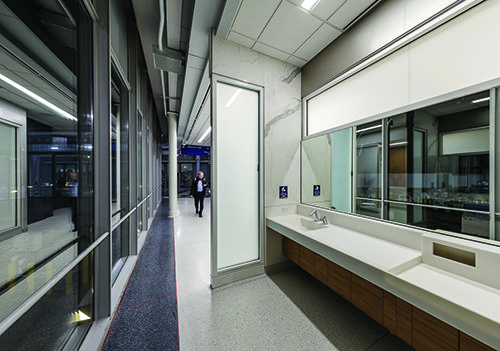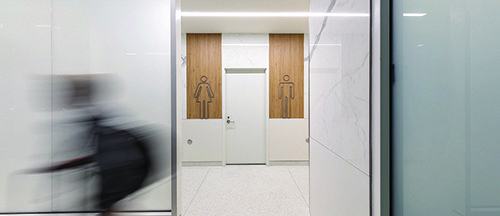As part of its ongoing commitment to customer service, Chicago O’Hare International Airport (ORD) refreshes its restroom facilities on a rotating three-year cycle. “They get a lot of traffic, so the goal, with the support of our airline partners, is to keep a nice, updated, uniform design throughout our terminals,” explains Alex Leon, deputy commissioner of design and GPS for the Chicago Department of Aviation.
As part of its ongoing commitment to customer service, Chicago O’Hare International Airport (ORD) refreshes its restroom facilities on a rotating three-year cycle. “They get a lot of traffic, so the goal, with the support of our airline partners, is to keep a nice, updated, uniform design throughout our terminals,” explains Alex Leon, deputy commissioner of design and GPS for the Chicago Department of Aviation.
The most recent refresh—22 restrooms in terminals 1 and 3—began in 2017 and ended in 2019. Renovations cost about $9.6 million and were rolled into the $8.5 billion “ORD21” capital improvement project, a plan designed to “meet the evolving needs of the traveling public through the 21st century and beyond.”
Providing larger restroom stalls was a key objective—and a direct response to feedback from passengers. “They have luggage and other stuff with them, so size is a challenge,” Leon says.
|
Project: Restroom Renovations Location: Chicago O’Hare Int’l Airport Owner/Operator: Chicago Dept. of Aviation Project Scope: Refresh 22 restrooms in terminals 1 & 3 Cost: $9.6 million Timeline: 2017-2019 Designer: Epstein Construction Management: Care Plus Contractor: FH Paschen Sinks, Faucets, Soap Dispensers: Sloan Wainscoting: Dupont Corian Acoustic Ceiling Panels: Navy Island |
But expanding the size of individual stalls required creativity, because the overall footprint of most restrooms could not be expanded. (Footprint sizes vary from 990 square feet to 1,775 square feet.) “We definitely lean on our designers to bring best practices, but we also look at other airports to see what they’re doing well,” Leon says. “It’s a combination of many different sets of expertise.”
Epstein, the Chicago-based design and construction firm hired for the project, scoured working restrooms and designer showrooms throughout the Windy City for ideas. Within the industry, it drew inspiration from airports such as San Francisco International and Minneapolis-St. Paul International.
Beyond assembling updated options for restrooms in terminals 1 and 3, Epstein also collected ideas for subsequent three-year cycles.
Laura Rebbe, senior project manager at Epstein, advises airports to keep the design process simple. “Try to envision yourself as a passenger just coming off a red-eye flight,” she suggests.
New Touches
Restrooms in terminals 1 and 3 now include sinks with integrated soap, water and air dryers at each station. The new arrangement helps reduce use of paper towels and minimizes the amount of water that guests drip onto the floor. SoundPly micro-perforated wood ceiling panels made by Navy Island help dampen the noise created from hand dryers; touchless faucets and other Sloan fixtures notify maintenance workers when they need service.
Designers also incorporated energy-efficient lighting and exhaust systems, and specified durable finishes designed to withstand the heavy traffic that ORD terminals regularly experience. Frosted glass allows borrowed, natural light from the concourse to filter into the restrooms.
The airport added several family restrooms and nursing facilities, with fixtures and amenities tailored to increase their functionality and accessibility. For instance, lower-height lavatories help young children use the restroom and wash up with less help from a mother who is nursing their sibling.
Restroom stalls in all of the renovated facilities are wider and deeper to improve circulation and comfort for guests. There’s even room for rolling luggage, which became much more ubiquitous when airlines increased fees for checked baggage.
In many cases, designers gained space for the increased stall depth by reducing the width of toilet plumbing chases and eliminating all other plumbing chases in the lavatory. This strategy also helped create room for additional mothers’ rooms, family rooms, additional stalls and larger aisles between the stalls and sink areas.
Where possible, ORD expanded the overall footprints of restrooms. In areas where the surrounding spaces allowed, walls were bumped out as much as possible—without making major infrastructure moves or investments, notes Leon.
 Stalls with extra room for rolling luggage and baby changing stations with diaper dispensers in all restrooms (not just women’s) are just some of the upgrades that reflect changes in passenger needs, he adds.
Stalls with extra room for rolling luggage and baby changing stations with diaper dispensers in all restrooms (not just women’s) are just some of the upgrades that reflect changes in passenger needs, he adds.
The refreshed restrooms feature a white and gray color scheme with accents of wood and frosted glass, white wainscoting and thin large-format porcelain tile. Wainscoting solid surface by Dupont Corian was seamed together onsite with solid surface counter materials from Sloan to eliminate cracks and simplify the cleaning process. “Durability was a major factor, but we didn’t sacrifice the look of the restroom,” remarks Jeffrey McQuiston, senior project architect at Epstein. “With newer construction technologies, a finish can be both durable and visually appealing. Airports do not need to limit themselves to stainless steel and plastic.”

Minimizing Disruptions
Completing restroom renovations at the busy airport was a challenge, but Leon notes that cooperation from the airlines, contractor, designer and Chicago Department of Aviation helped minimize the impact to passengers. “Airlines within the various locations have a better sense of how they operate in terms of moving passengers,” he explains. Gate utilization was shifted based on usage to accommodate construction, while messaging—both static signs and audio announcements—alerted passengers to restroom closures and provided instructions to help them find the nearest available facility. A two-phase construction plan ensured that multiple restrooms were not closed within the same terminal at the same time, Rebbe adds.
 When removing walls, contractors encountered unexpected infrastructure, such as wires and pipes that were not detailed in terminal documents. Although this could have easily delayed the schedule, Leon credits close coordination among project stakeholders for enabling quick adjustments in the field. “From a construction standpoint, that was one of the lessons learned,” he states. “For the next refresh, we will do a lot more verification to make sure that the as-built drawings are correct—that utilities and other things weren’t moved over the years without us keeping inventory.”
When removing walls, contractors encountered unexpected infrastructure, such as wires and pipes that were not detailed in terminal documents. Although this could have easily delayed the schedule, Leon credits close coordination among project stakeholders for enabling quick adjustments in the field. “From a construction standpoint, that was one of the lessons learned,” he states. “For the next refresh, we will do a lot more verification to make sure that the as-built drawings are correct—that utilities and other things weren’t moved over the years without us keeping inventory.”
Next Round
As ORD looks ahead to future restroom renovations, the project team continues to study best practices at airports and other facilities that regularly accommodate large groups of people. Between ORD and Midway International, the Chicago Department of Aviation processes more than 105 million passengers annually.
Taking the current COVID-19 pandemic into consideration, Leon notes that ORD’s next restroom project might incorporate technology and amenities specifically selected to help slow the transmission of viruses. For example, the recently completed refresh includes hand dryers, because they were considered to be more sanitary and environmentally friendly than paper towels at the time. New information, however, could favor disposable paper towels, because automated hand dryers may cause viruses to become airborne. “We designed it with a different mindset,” Leon reflects. “So while we think those were good features and ideas then, there may be different guidelines in the future.”



 facts&figures
facts&figures

